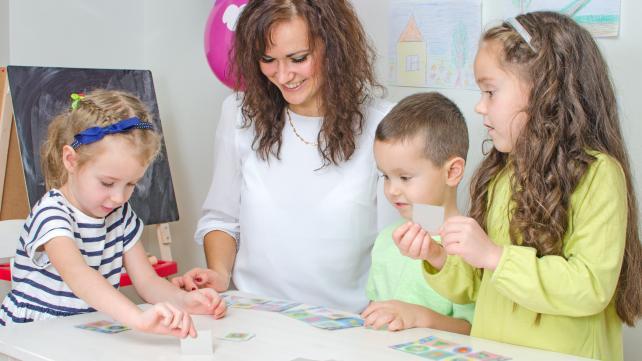
When I think of skills that are important for life, communication is at the front of the line. I don’t just mean knowing how to string letters together to make words or even knowing how to spell those words correctly, though both of these definitely have their place and value.
Communication, to me, is really about being able to relay ideas and information in ways that others can understand. It is a learned skill that impacts many areas of our lives, personal and professional, every single day.
For children, learning to communicate effectively often gets limited to academic workbooks and assignments focused on reading and writing. But the art of communicating effectively and the fun of exploring the myriad of ways that human beings can express themselves to others gets left behind. It’s for this reason that I’ve always turned to games for helping my own children build their communication skills. Games make communicating fun and engaging, while building serious skills in language, communication, critical thinking, and logic.
Here are five games that I’ve played with my own children over the years to help develop their communication skills. All of these are TV/device free so be prepared to be actively present and engaged with your children while playing.
Making a Story
Children love to tell stories. They love to hear stories as well. This game does a little bit of both and works wonders for helping long car rides fly by faster.
Objective: To create a story as a family made from the imagined details of each person playing. Note: Your story may end up being totally ridiculous and that is part of the fun!
Skills Practiced: imagination, creativity, sequencing and ordering thoughts and information, memory and recall, building vocabulary
How to Play:
Step 1: Mom or Dad begin by announcing a story start of their choice. You can say something like “once upon a time” or “one day a little girl walked outside, looking for an adventure” or “on a dark and stormy night.”
Step 2: After the story is started, the next person playing will add to the story whatever details they want to add.
Step 3: Each person playing continues adding details to the story each time they have a turn until the story comes to an end. Each person’s additional story details must continue from wherever the last person left off!
Taboo
Taboo is one of my favorite language-based games from childhood, after Scrabble of course. It’s a card-based language game that is fun for weekly family time, birthday parties, or even larger family get-to-gethers.
Objective: Get your team to guess the secret words without saying any of the related words on the card before the time runs out.
Skills Practiced: descriptive communication, use of metaphor and similes, speaking in front of an audience, teamwork, learning to win and lose graciously
How to Play:
Step 1: Divide into teams.
Step 2: Each person on the team will have a turn giving clues to their team about the secret word but they cannot say any of the other closely related words on the card.
Step 3: For each word guessed correctly, the team gets a point. If one of the taboo words is said, the card goes back into the pile. Try to go through as many cards as you can before time runs out. The team with the most points wins.
Concentration
This is a good one for vocabulary building and works well for older children because of the added element of multitasking.
Objective: Continue the rhythm without interruption while also naming words that belong to the selected category in alphabetical order.
Skills practiced: vocabulary building, multitasking, maintaining a rhythm, ordering and sequencing, pacing language
How to Play:
Step 1: Decide as a family what category of words you will be using for the round. The categories can be anything you and your children know a lot of words for like food, drinks, animals, sports teams, book titles, etc. Also decide who will begin the first word in the round.
Step 2: Mom or Dad begins the rhythm by clapping twice on their thighs and then twice in their hands while saying “CON-CEN-TRA-TION”, matching the syllables to the claps. If your children need help getting into the rhythm, you can continue the clapping beat for as long as you need to until they are ready.
Step 3: Once CON-CEN-TRA-TION has been announced, the first player announces their word to the group in alphabetical order, beginning with A. Since the beat begins with a thigh clap, the words announced need to be said on the thigh clap as well.
Step 4: Each player takes turns announcing their words for the category, following alphabetical order, on the correct beat. If they can’t think of a word before the beat moves on, they are out. If they say their word on the wrong part of the beat, they are also out.
Here is an example if you are playing with the category of food:
Parent: CON-CEN-TRA-TION (clapping on thighs and hands according to the syllables)
Player 1: Apples, CLAP-CLAP.
Player 2: Bananas, CLAP-CLAP.
Player 3: Cookies, CLAP-CLAP.
Player 4: Dates, CLAP-CLAP.
Player 1: Uhmm, CLAP-CLAP. This player is out and you start again from the last letter you left off on until only one player remains.
Blind Drawing
This game challenges children to use descriptive and precise language to communicate efficient directions.
Objective: Get your partner to draw the correct image by giving precise and detailed directions.
Skills practiced: listening, inferring, giving specific instruction, translating images into words, following directions
How to Play:
Step 1: Mom or Dad draw a simple image on paper that no one is allowed to see.
Step 2: Split the kids into pairs. One child in each pair needs to be blindfolded (or turned around so they cannot see behind them) and given a piece of paper and pencil. This child is the artist. The other child will be the director.
Step 3: Show your image to the director and set a timer for 3 minutes. When the timer begins, the director must instruct the artist how to draw the image without allowing them to see the image or telling them what the image is.
Step 4: When the timer is up, unblind the artist and see how close they came to the image. If they were able to draw it well, they win. If they were way off, have a good laugh and start again, switching directors and artists.
20 Questions
Another good game for long car rides, 20 Questions combines language and vocabulary with a bit of mystery and deductive reasoning.
Objective: To guess the secret word in 20 questions or less.
Skills Practiced: vocabulary building, deductive reasoning, debate, asking the right questions, memory and recall, ordering and evaluating information
How to Play:
Step 1: Everyone playing agrees to a category to play from. I’ll explain the rest using the example of animals. Mom or Dad then think of an animal in their head and don’t tell anyone what it is.
Step 2: Players take turns asking Yes or No questions to try and figure out what animal mom or dad are thinking of. They are not allowed to guess the animal by name unless they strongly believe they have figured out which one it is. Mom or Dad are only allowed to respond either “Yes” or “No” to each question. Maybes, sometimes, or any additional details are not allowed to be given as responses.
Step 3: The game ends either when the 20 questions are finished (and everyone is stumped) or when someone guesses the animal correctly. If a player guesses the animal by name and gets it wrong, they are out of the game. The key to playing this game well is teaching the children/ players to ask questions that reveal additional information, characteristics and/or behavior about the animal to reason what kind of animal it is rather than just guessing through a list of possible names. The rules of this game can also be modified depending upon the children’s ages.
Games can be a wonderful tool for helping children to build their communication skills. The best part is that they end up having so much fun that they don’t even realize how much real learning and skills building they are doing along the way.
Melissa Barreto is a home educating mother of five children and the Co-Founder of Wildflower Homeschool Collective, a homeschool organization based in Northern New Jersey.




Add new comment